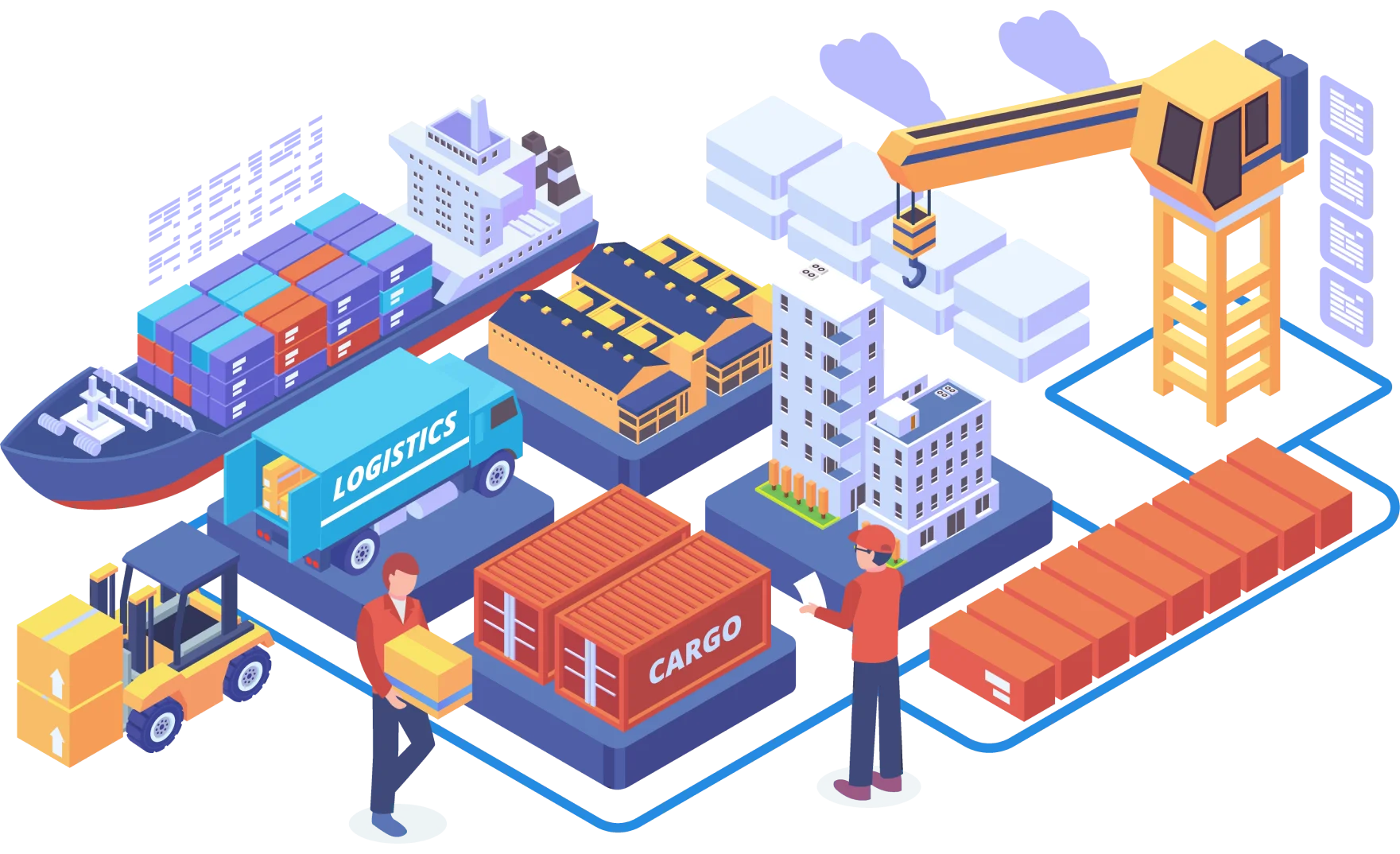Reliable Transportation Management Solutions For Your Business
Tired of unreliable, costly deliveries? We’ll manage your transportation, you focus on growth.
How It Works
Here’s how we take charge of your shipping operations in 3 simple steps.
Consult
Discuss your shipping challenges with our transportation experts.
Strategize
Receive a tailored plan that fits your resources and business goals.
Implement
We execute the plan, monitor progress, and adapt quickly to maximize your growth.
Inefficient Shipping Management Stunts Your Business Growth
Many companies can’t retain qualified carriers. So they end up choosing between higher costs or delayed deliveries. And the lack of expertise in assessing cost-effective shipping options further strains transportation departments across the US.
This combination can severely limit a company’s ability to compete in today’s fast-paced market.



Your Partner in Hassle-Free Transportation Management
Imagine a shipping department that:
- Consistently meets deadlines
- Controls costs
- And scales with your growth
That’s what we deliver. At Supply Chain Solutions, our end-to-end transportation management frees you to focus on expanding your business.
End-to-End Transportation Management, Tailored to Your Business
Planning Shipments
We optimize routes, vehicle selection, and costs for efficient point-to-point material transport.
Finding Trucks
Access our network of reliable carriers to meet your capacity needs.
Tracking Shipments
Monitor your shipments in real-time from departure to arrival for precise location and ETA updates.
Handling Paperworks
Drowning in shipping paperwork? We manage all shipping documentation with accuracy and compliance so you don’t have to.
Managing Fleet
Stop stressing about truck breakdowns. Our network of trusted carriers ensures consistent shipping capacity
for
your business
Technological Support
Gain a competitive edge with our advanced logistics technology. Our user-friendly systems give you real time insights for operational efficiency.
How MFF Scaled Their Business with Our Managed Transportation Service
Our flexible carrier partnerships helped MFF move away from a high-cost, inefficient dedicated fleet to a diversified carrier base. Together, we achieved a:
- $1M annual reduction in operational costs
- Significant boost in customer satisfaction
- Strengthened market position

What People Say
Real stories from businesses we’ve helped streamline and scale.
 YOU ARE THE ABSOLUTE BEST! Seriously sometimes you read my team’s mind. Thank you!
YOU ARE THE ABSOLUTE BEST! Seriously sometimes you read my team’s mind. Thank you! The Supply Chain Solutions team provides seamless and reliable support. It makes a real difference in our day-to-day operations.
The Supply Chain Solutions team provides seamless and reliable support. It makes a real difference in our day-to-day operations. We have had a long-term relationship together that continues to thrive.
We have had a long-term relationship together that continues to thrive. Ready To Optimize
Your Shipping Department?
Transform your transportation from a bottleneck to a business asset. Schedule your free expert consultation today.
Frequently Asked Questions
– What are the advantages of using a transportation management system (TMS) for logistics operations?
In today’s fast-paced logistics landscape, the advantages of using a Transportation Management System (TMS) are undeniable and essential for any business looking to stay ahead. Here’s how a TMS can transform your logistics operations:
1. Streamlined Logistics Activities
A TMS simplifies the often complex logistics processes by automating tasks such as planning, carrier selection, execution, and settlement. This automation not only reduces manual errors but also speeds up operations, enabling businesses to respond swiftly to market changes.
2. Enhanced Cost Efficiency
By optimizing route planning and carrier procurement, a TMS helps contain costs while improving service delivery. It takes into account various factors like fuel consumption, backhaul opportunities, and carrier rates, thus ensuring cost-effective operations without compromising service quality.
3. Improved Visibility and Control
One of the significant benefits of a TMS is real-time tracking and monitoring of shipments across all modes of transport. This visibility allows shippers to make informed decisions quickly, adjusting routes or carriers as needed to prevent delays and improve customer satisfaction.
4. Scalability and Flexibility
Transportation management systems are designed to grow with your business. They provide the flexibility needed to handle increased shipment volumes, expanding to accommodate more routes, carriers, and even international shipping challenges seamlessly.
5. Data-Driven Insights
Analytics and reporting capabilities within a TMS offer invaluable insights into logistics operations. Businesses can track performance metrics, identify inefficiencies, and make data-driven improvements, thereby achieving operational excellence.
Ultimately, a Transportation Management System streamlines logistics processes, drives down costs, enhances visibility, and provides a scalable platform that grows with your business needs. By harnessing these advantages, companies can not only maintain but improve their competitive edge in an ever-evolving market.
– What are the key features of a transportation management system that supports international logistics?
A transportation management system (TMS) is integral to efficiently managing international logistics operations. Here are the key features that make it indispensable:
1. Comprehensive Planning and Execution
A sophisticated TMS facilitates both planning and execution of logistics tasks. It enables shippers, freight forwarders, and logistics service providers (LSPs) to streamline their operations by seamlessly managing shipments across various modes—road, ocean, rail, air, and parcel.
2. Multi-Modal Capabilities
A robust TMS supports a wide range of transportation modes. Whether shipping by road, sea, air, or rail, a TMS provides integrated solutions for all, ensuring flexibility and adaptability to meet different logistical needs across global regions.
3. Carrier Procurement and Management
Efficient carrier procurement is vital for international logistics. A TMS simplifies this process by providing tools for selecting, negotiating, and contracting with carriers, ensuring the best match for specific requirements and cost-effectiveness.
4. End-to-End Shipment Tracking and Visibility
Visibility is crucial in international logistics. A TMS offers end-to-end tracking capabilities, keeping you informed about shipment statuses in real-time, regardless of the transportation mode or geographic region, thereby enhancing reliability and customer satisfaction.
5. Seamless Integration and Interoperability
Transportation management systems are designed to integrate with other supply chain solutions, enabling seamless communication and data exchange. This integration supports efficient logistics operations and helps position your business within a broader global ecosystem.
6. Global Reach and Scalability
By leveraging a TMS, businesses can tap into the world’s vast transportation network, enhancing their global reach. Scalability ensures that as your business grows, the system adapts to increased volumes and complexities, supporting sustained expansion and operational excellence.
Incorporating these features into a TMS not only optimizes logistics activities but also provides a strategic advantage in international markets.
– What role do data and analytics play in managed transportation?
In today’s fast-paced logistics landscape, data and analytics serve as the backbone of managed transportation. These tools are instrumental in transforming complex supply chain activities into streamlined operations.
– Centralized Communication and Integration
At the heart of managed transportation is the Transportation Management System (TMS). This software acts as a pivotal communication hub, seamlessly connecting clients, carriers, and vendors. Through integration, TMS sorts and synthesizes vast amounts of data generated by daily operations, ensuring that all parties remain connected and informed.
– Real-time Tracking and Strategic Insights
One of the primary benefits of integrating a TMS is real-time tracking. With shipments constantly on the move, having up-to-the-minute updates helps avoid unexpected delays and enables proactive problem-solving. This transparency fosters trust with clients as they are continuously informed about the progress of their shipments.
Moreover, data analytics unlocks strategic insights, empowering businesses to make informed decisions. By analyzing trends and patterns, companies can optimize routes, enhance inventory management, and predict future demands. These insights not only boost efficiency but also lead to cost reductions and improved service quality.
– Enhanced Decision-Making and Cost Efficiency
Data-driven analysis plays a crucial role in enhancing decision-making. By merging external data from partners with internal processes, businesses can fill informational gaps and resolve discrepancies. This comprehensive understanding enables precise inventory control and operational cost management.
In essence, data and analytics are not just supportive tools but foundational elements driving the transformation of the logistics industry. As technology advances, their role will only grow, unlocking new opportunities for efficiency and innovation in managed transportation.
– How should technology be evaluated when choosing a managed transportation partner?
Selecting a managed transportation partner is a critical decision, and evaluating their technology is a key component of this process. Here’s how to assess the Transportation Management System (TMS) to ensure it aligns with your business goals:
– Assess Current Needs and Future Scalability
- Begin by ensuring the TMS can handle your current logistics operations efficiently.
- Look for technology that offers scalability, allowing it to adapt as your business grows or shifts.
– Evaluate Flexibility and Customization
- Choose a TMS that can be tailored to your unique business processes.
- Ensure it can integrate with existing systems to streamline operations and data flow.
– Consider Data Visibility and Analytics
- Check if the system provides real-time data visibility for tracking shipments and making informed decisions.
- The system should offer robust reporting and analytics tools to help optimize routes, reduce costs, and improve service levels.
– User Experience and Support
- Ensure the TMS is user-friendly, with an intuitive interface that minimizes the learning curve.
- Investigate the support and training services provided to help your team make the most of the technology.
– Compare Multiple Options
- Don’t settle for the first option. Compare several TMS solutions to understand the strengths and weaknesses of each.
- Consider seeking feedback from current users or reviewing case studies to gain insights.
Finally, ensure the technology aligns not just with your logistical needs but also with your company’s broader strategic objectives. Making a well-informed decision now can lead to increased efficiency and cost savings down the road.
– What are the key considerations for implementing managed transportation?
Implementing managed transportation successfully involves several crucial factors. Here’s a guide to help you navigate the process:
– Clearly Define Your Objectives: Begin by setting clear goals and defining key performance indicators (KPIs). This step ensures that everyone within the organization is aligned, fostering stronger collaboration and a unified vision for the partnership.
– Assess the Technology: When selecting a Managed Transportation Services (MTS) provider, evaluate their Transportation Management System (TMS) thoroughly. It should not only address your current operational needs but also contain the flexibility to scale with your business as it evolves. Consider how it compares with other available systems in terms of integration capabilities and user-friendliness.
– Select the Right Carriers: Whether you or your MTS provider maintain relationships with truckload and less-than-truckload (LTL) carriers, ensuring they align with your strategic goals is vital. This alignment helps optimize logistics performance and improves service quality.
– Leverage Data and Analytics: A robust managed transportation solution should offer enhanced visibility through comprehensive data and analytics. This functionality enables making informed, timely decisions, which can significantly improve efficiency and cost-effectiveness in your supply chain operations.
– Ensure Robust Freight Audit and Payment Processing: Accuracy in freight billing is essential. Choose a partner who offers meticulous freight audit and payment services to maintain compliance and ensure your invoices are paid promptly and correctly.
– Prioritize Customer Support: Continuous support from your MTS provider can significantly impact the success of your logistics operations. Look for a partner that offers dedicated teams to handle challenges and adapt to changing needs, whether it’s due to market shifts, new customer demands, or seasonal fluctuations.
By focusing on these considerations, you can effectively capitalize on managed transportation to streamline your operations and achieve your business objectives.
What should a company consider when defining goals for managed transportation?
Defining clear and strategic goals is a crucial step for any company entering a managed transportation partnership. Here’s what you should keep in mind:
1. Identify Key Performance Indicators (KPIs): Start by determining what metrics will best measure success. This might include delivery times, cost savings, or improvements in customer satisfaction.
2. Engage Stakeholders: Ensure you have the support and input of all involved parties, from logistics teams to finance. Their buy-in is essential for setting realistic goals and ensuring everyone is aligned.
3. Assess Current Needs and Challenges: Understand your current transportation processes and identify areas that need improvement. Knowing your pain points will help in setting achievable and relevant objectives.
4. Consider Long-term Vision: Think beyond the immediate benefits. Define goals that support your long-term strategic vision and can adapt to future changes in your business landscape.
5. Benchmark Against Industry Standards: Research and compare your objectives with industry norms. Tools from third-party analytics providers may offer valuable insights into setting competitive and innovative goals.
By focusing on these aspects, your company will establish a strong foundation for a successful managed transportation strategy.
What Are the Risk Management Benefits of Managed Transportation Services?
Managing logistics can be a daunting task for any business, often prone to delays and disruptions. So how can managed transportation services help? Here’s a closer look at the risk management benefits.
1. Enhanced Reliability and Reduced Delays: By outsourcing logistics to a fourth-party logistics (4PL) provider, companies can experience fewer hiccups in their supply chain. These providers have the expertise to foresee possible disruptions and adjust strategies accordingly to keep operations running smoothly.
2. Strong Carrier Relationships: 4PL providers maintain robust relationships with carriers, ensuring priority handling and flexible solutions during peak times or unforeseen circumstances. This minimizes the risk of sudden shipping issues impacting your business.
3. Optimized Supply Chain Design: With a focus on efficiency, these services analyze and redesign supply chain networks to eliminate bottlenecks and redundancies. Such optimization ensures that inventory moves efficiently, reducing the chance of stockouts or overstock situations.
4. Insightful Data and Analytics: Access to real-time data allows for informed decision-making. By leveraging actionable insights, businesses can quickly identify and address potential risks before they escalate into significant problems.
Choosing to use managed transportation services means taking proactive steps to safeguard your operations against the unpredictable nature of logistics. This strategic partnership empowers businesses to stay ahead of challenges while maintaining a focus on core activities.
How Do 4PL Providers Create Long-Term Solutions for Supply Chains?
Creating long-term solutions for supply chains involves more than just managing logistics; it requires strategic planning and expertise. This is where Fourth-party logistics (4PL) providers step in.
– Access to Industry Experts
4PL providers bring a wealth of industry expertise to the table. They work as strategic partners, offering comprehensive oversight of your supply chain operations. This includes everything from optimizing network design to improving carrier relationships. Their experience ensures that each part of the supply chain is not only functional but also efficient and adaptable to changes.
– Advanced Technology Integration
Modern supply chains need modern solutions. 4PL providers utilize cutting-edge transportation management systems (TMS) to streamline operations. These advanced technologies provide real-time data, enhancing transparency and decision-making. With the right tools, businesses gain visibility into every supply chain segment, allowing them to respond swiftly to any disruptions or inefficiencies.
– Comprehensive Management Solutions
Managing a supply chain is a complex task, involving numerous components like carrier management, freight analytics, and reporting. 4PL providers take on these tasks with precision, ensuring all parts of the supply chain work synergistically. By centralizing these processes, they eliminate redundancy and improve overall performance.
– Scalability and Flexibility
As businesses grow, their supply chains must scale accordingly. 4PL providers design solutions that are not only robust but also flexible. They can adjust strategies to accommodate seasonal demands, market fluctuations, or new business developments without compromising efficiency.
In summary, 4PL providers craft long-term solutions through expert management, advanced technology, and a focus on adaptability. They ensure that your supply chain isn’t just operational but also a strategic asset that supports your business goals.